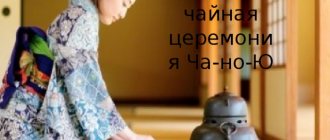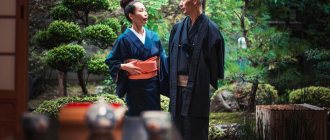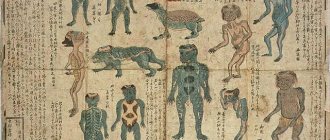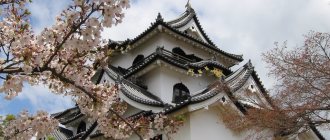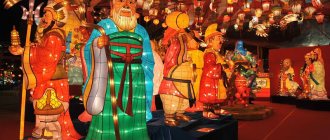Presentation on the topic: Ikebana - the art of arranging flowers
Ikebana - the art of arranging flowers
Ikebana - translated into Russian means “Life of Flowers” (Ike - “life”, Bana - “flowers”) - the traditional Japanese art of arranging; creating compositions from cut flowers, shoots in special vessels and placing them in the interior.
From the history of ikebana Initially, ikebana was based on the philosophical and aesthetic postulates of Shintoism, and then Buddhism. According to Shintoism, every natural object, body, phenomenon contains a divine spirit and therefore requires respectful treatment as a living being. The Japanese love to identify with nature, striving to live with it without any barriers and maintaining a balanced coexistence. Its origins are associated with the ancient custom of presenting flowers to deceased ancestors. In Buddhist temples, a ritual of placing flowers on Buddha statues developed. At the same time, the perfect shape of the vase and the lush, pompous splendor of the bouquet itself, which was created according to certain, strictly canonized rules, embodied the triumph and grandeur of Buddhism. But as world and national culture developed, the philosophical and religious meaning of ikebana was gradually lost. The emergence of ikebana in Japan as an art dates back to the 15th century; at that time it was practiced mainly by clergy of temples and monasteries. But gradually it becomes popular among the upper echelons of society, and then widely enters the everyday life of the people and is more often perceived as an object of true art.
RICKY. The structure of ikebana is determined by its style, school and form of composition. The history of ikebana art begins with the creation of a magnificent ceremonial style, which was called Rikki (literally - “arranged flowers”), which means “standing flowers”, towering high above their patterned bronze vessels, which, along with other temple decorations, were brought from China. The tips of the branches, as well as the flowers, were directed towards the sky, symbolizing faith. The compilers of the rikki proceeded from the position that the flowers must somehow represent the sacred Buddhist mountain Sumisen, a symbol of the universe. The rikka arrangement was often called a “small garden inside the house” because the artist created a miniature landscape in his composition.
SHOKA (Seika). This new and simpler style of ikebana appeared in the 15th century. along with architectural simplifications. Both large buildings and small houses built during this period reflected a love of simplicity. The basis of a seca style composition is made up of three main branches, complemented by shorter branches and flowers, placed in a row one after another, but creating the effect of emerging from a single trunk and not touching the walls of the vase. The assortment of seki is limited to one or two plant species and rarely reaches three. Seka in translation means approximately the same as the word ikebana, namely: arranged flowers, fresh flowers, or the ability to display flowers in a favorable light.
MORIBANA. Compositions in low and flat vases, which characterize the Moriban style, have existed for about 80 years. The moribana style (translated as "pile of flowers") combines the formal rikka style and the naturalistic nageire style in equal measure, with an additional third element - the creation of some kind of landscape or picture of nature so that the arrangement gives the impression of a landscape. Greenery and flowers are used more abundantly than in the arrangements of the first two styles. Moribana is a natural form of expression aimed at reproducing a landscape or part of a garden in miniature. To create ikebana in the Moribana style, kenzan is also used, which is a metal stand with a heavy base and needles, between which flowers and branches are attached. The appearance of Moribana is associated with the need to decorate European houses that were alien to convention, which appeared in Japan in the second half of the 19th century, when the country established ties with Western countries.
NAGEIRE. This style appeared in the 14th century. in connection with the creation of tea houses, where masters of the tea ceremony gave a less formal look to their flower arrangements. This resulted in a naturalistic arrangement known as nageire, which means “thrown flowers.” Just like the seka style composition, it is made up of three components forming a scalene triangle. Unlike seki, where the formal group is pressed tightly against the kenzan and no part of the arrangement touches the sides of the vase, this style allows for a looser arrangement where the flowers can rest on the rim of the vase's neck. Nageire uses tall vases in which branches and flowers are fixed without any special devices, although there are several ways to fix them in vases.
A brief history of ikebana. Three main schools, hundreds of styles, millions of fans
Ikebana in a broad sense is:
- Japanese art of creating bouquets from cut flowers and their parts (including already dried ones) and other floral elements;
- a ready-made bouquet created according to the canons of this art.
The word “ikebana” itself consists of two hieroglyphs: “life” and “cut flowers,” which in combination can be interpreted as “the second life of cut flowers.” Japaneseists, however, emphasize: in fact, the term does not have a literal translation; its meaning is too deep. This is a showing of a person’s place in the world, and a reflection of the individuality of the one who compiled the composition, and a demonstration of acceptance of the natural course of life, part of which is the inevitable dying, finding aesthetics in this, and much, much more.
Initially, petals and cut flowers were used in Buddhist rituals, so we can say that the “cradle” of ikebana is India, where the teaching arose. When Buddhism began to spread in Japan (this is the 6th century), the practice of offering flowers migrated to the islands. Only the clergy knew how best to manage the flora as gifts to Buddha and decoration of temples.
In search of enlightenment
The oldest school of ikebana, Ikenobo, originates from the ideas of the Kyoto priest Ikenobo Senkei. The master was so skilled in composing beautiful compositions that clergy from all over the country came to learn his skills.
The style originally characteristic of this school is called rikka. We focus on this, because in the 21st century there are already several hundred schools and styles. But all of them, one might say, came from Ikenobo.
The classic rikka style is characterized by tall (over one and a half meters) compositions with the main plants consisting of: pine, bamboo, lotus. Let us remember that we are talking about the glorification of Buddha. The lonely pine is a tree symbolizing the nature of the enlightened. Bamboo signifies a perfect person. Well, for the entire East, the lotus is a sign of spiritual revelation. Although, strictly speaking, these are also simplified meanings, there are others, both purely Buddhist and local, Japanese, associated with Shintoism, the traditional religion of the islanders.
Inevitably, such a beautiful process as making flower arrangements (albeit with a special meaning) had to leave the temples for the people. This is what happened over time. First, ikebana appeared in the imperial house, then, gradually, they began to gain popularity among the entire population.
By the 16th century, the religious significance of ikebana had diminished. The sex style was born. On the one hand, it is a simplified rikka (for the masses). On the other hand, over the years, the art of composing flower arrangements has become “saturated” with a specific Japanese attitude to beauty and existence.
There were no longer such strict dogmas about verticality, but it was absolutely necessary to maintain the balance of all parts of the composition aesthetically and meaningfully.
The ability to create ikebana became mandatory for geishas, but men were widely involved in this art. Samurai, before a battle from which they might not return, created ikebana. Can you imagine what deep meaning concerning human life they invested in their composition?!
Instructions were written about how the bouquets were to be arranged. Their study, knowledge and precise execution have become mandatory. It’s not that “step left or right” is not allowed at all, but the principles of creating ikebana evolved very slowly.
This would have continued if the Europeans had not intervened...
Ikebana of the Ikenobo school
Beginning in the mid-19th century, Japan's isolation from the rest of the world came to an end. Enormous changes have affected all spheres of life in the country; of course, the process also affected ikebana.
- Firstly, the Japanese were faced with an unusual view of life, man, and a hitherto unknown philosophy. And this is exactly what ikebanists reflect in their works. And even though the majority frankly did not understand Westerners (and some were imbued with ideas brought from overseas), new notes began to appear in flower arrangements.
- Secondly, and probably most importantly, new flowers began to be brought to Japan, the use of which was simply not prescribed in the old dogmas. We had to revise the rules. So the art of ikebana began to develop a little violently.
By the end of the 19th century, a former representative of the Ikenobo school named Unshin Ohara began using unusual vessels for his works and “gave life” to new styles (this was a real breakthrough!):
- Moribana - the elements of the composition were installed in shallow bowls, possibly even with water;
- heika - when plants were placed in tall narrow vases and fixed in a vertical position, sometimes hanging bizarrely, it was not even clear how or what they were holding on to.
The master opened his Ohara school. This is the second classical school of ikebana.
Ikebana in Moribana style
Ikebana in a tall narrow vase
Finally, in 1927, the Sogetsu School opened, the third main school of ikebana.
Its representatives, on the one hand, do not renounce traditional Japanese philosophy (it was, is and will be an obligatory invisible component of any composition, otherwise it will not be ikebana at all, but an ordinary bouquet), but on the other hand, they are open to everything new. It was the ikebanists of this school who began to actively use modern materials, and if they appear these days, they will not fail to use them. According to adherents of the Sogetsu school, ikebana should not stand still; its task is to develop along with the changing world. The rules of the past are good, but only as a basis, a springboard from which to build.
Most likely, it was thanks to this school that ikebana began to gain popularity among non-Japanese people.
A new look at ikebana
Today in the Land of the Rising Sun there are many styles of ikebana, but the classic, basic ones are those practiced in the first three schools: Ikenobo, Ohara and Sogetsu. They exist to this day, each has its own adherents, there is healthy competition between them, which ultimately only benefits everyone.
Presentation on the art of ikebana technology
Description of the presentation by individual slides:
Contents What is ikebana? History of Ikebana Schools of Ikebana Principles of Ikebana
Ikebana or ikebana (生け花 or いけばな, “ike” - life, “bana” - flowers) is the traditional Japanese art of arrangement; creating compositions from cut flowers, shoots in special vessels and placing them in the interior.
Ikebana originated in China in the 7th century. It was invented by a Buddhist priest, originally it served as an offering to the gods and was created by monks. By the middle of the 15th century, with the advent of the first classical styles, ikebana acquired the status of art.
